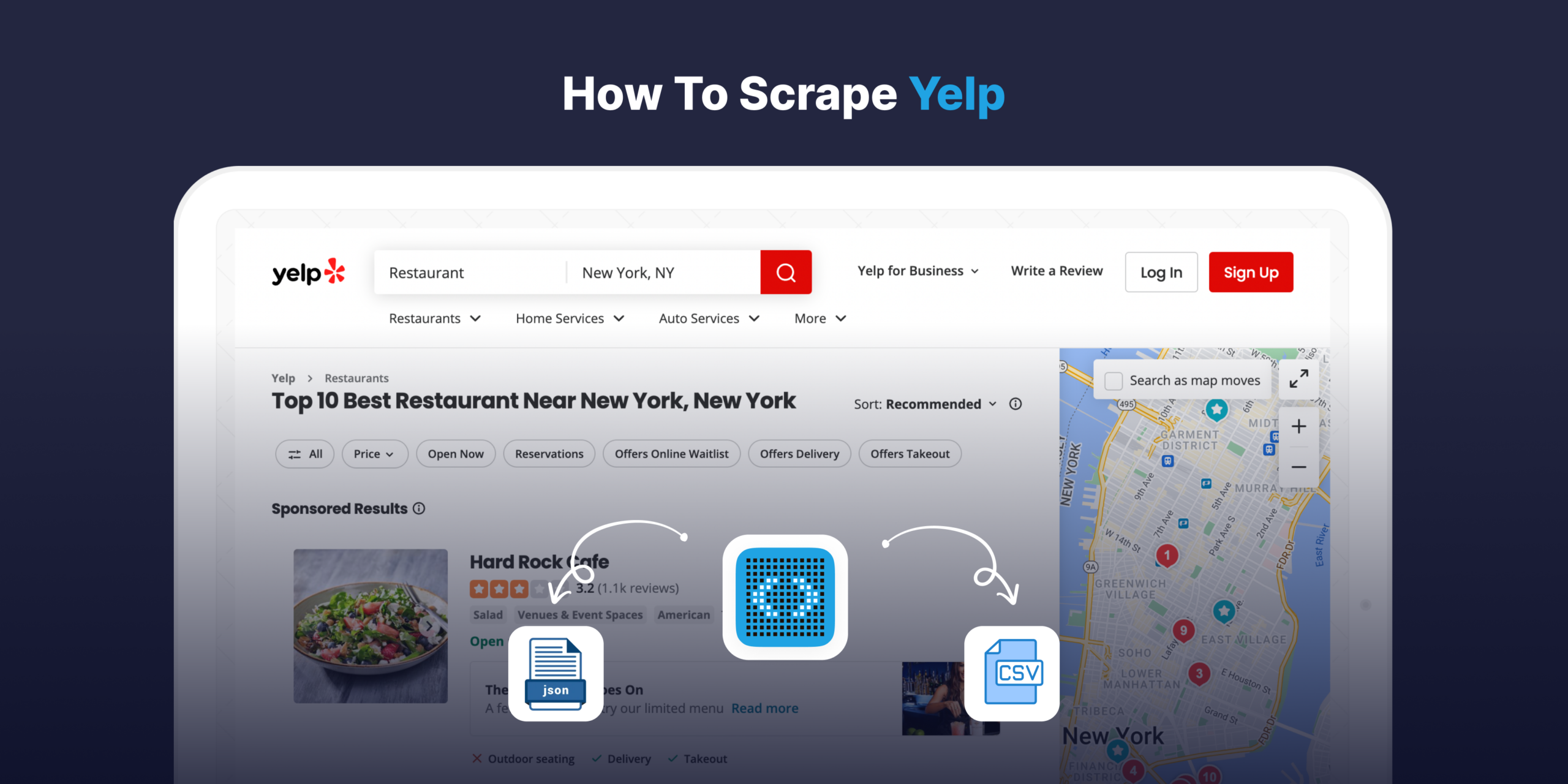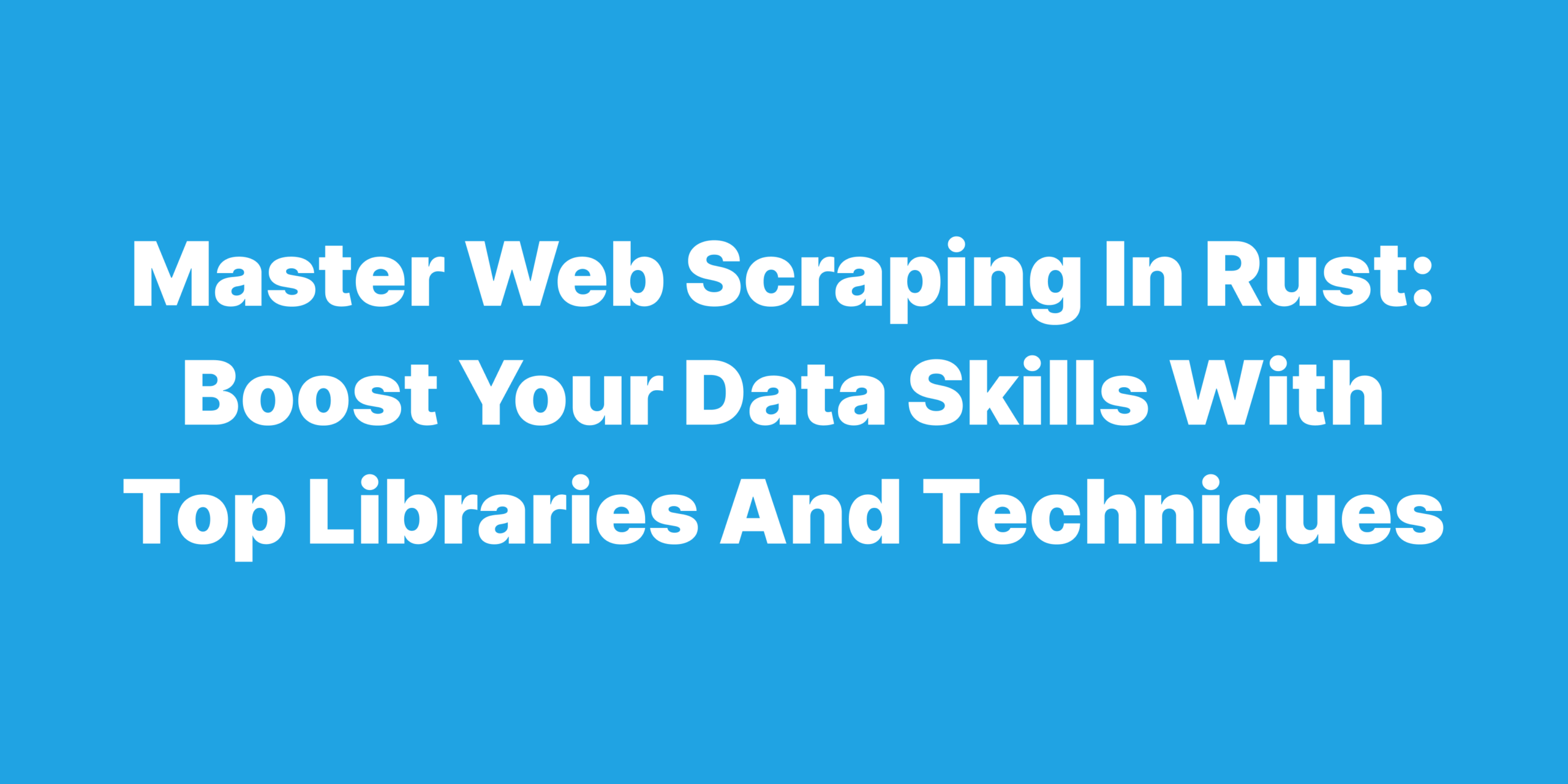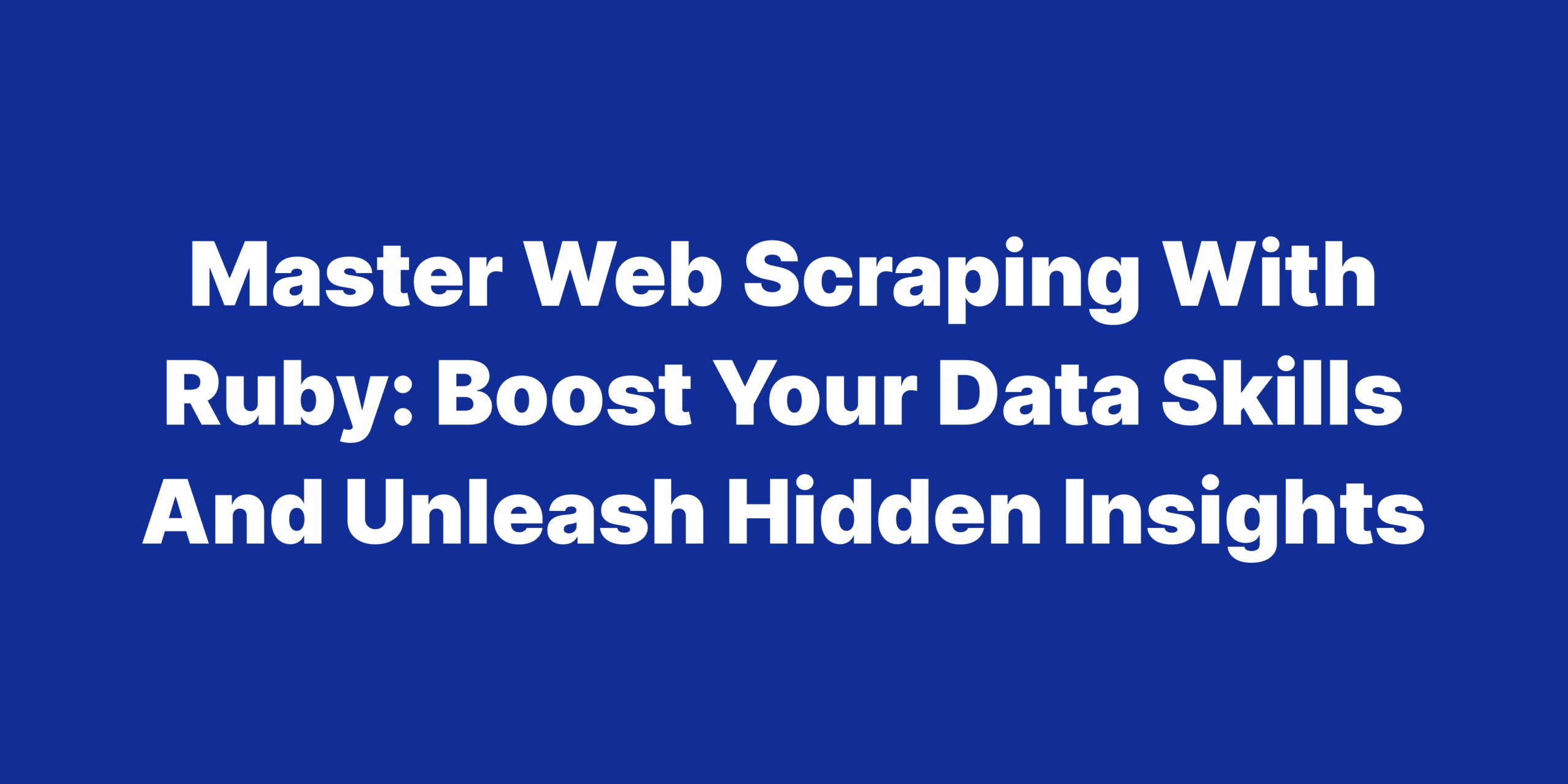Web scraping is a powerful technique for extracting data from websites, enabling users to gather specific information from various sources across the internet. It automates the process of retrieving data from HTML or XML documents, converting it into a structured format such as a spreadsheet, CSV file, or database. With the rise of big data, web scraping has become crucial for analysts, researchers, and businesses aiming to collect and analyze vast amounts of web information, leading to more informed decision-making and valuable insights. To facilitate this, leveraging a web scraping API can significantly simplify the process, providing a powerful tool for those looking to extract web data efficiently.
In the realm of data analysis, mastering web scraping is essential for accessing previously untapped or hard-to-reach data. It allows analysts to efficiently compile information from multiple web sources, which can then be processed, analyzed, and visualized to reveal patterns, trends, and relationships. This article delves into the world of web scraping with Scala, a versatile and potent programming language ideal for data extraction tasks. We will guide you through the basics of starting with web scraping in Scala, from identifying HTML objects by ID to comparing the top libraries for web scraping, and provide a roadmap for building your own web scraper. Additionally, we’ll explore how to parse HTML code using Scala libraries, empowering you to unlock the full potential of web scraping in your data analysis projects.
Discover the Potential of Web Scraping with Scala: A Comprehensive Guide
Scala, a high-level programming language that combines the flexibility of Java with the elegance of functional programming, is an excellent choice for web scraping tasks. Its robustness, expressive syntax, and powerful libraries make it a popular choice among data enthusiasts who seek to extract valuable information from the web. Additionally, Scala’s parallelism and concurrency features enable users to manage and process large amounts of data efficiently.
Before diving into web scraping with Scala, it’s crucial to set up the appropriate environment. Start by installing the latest version of the Scala programming language and a suitable Integrated Development Environment (IDE), such as IntelliJ IDEA or Eclipse, which offer Scala support. Next, you’ll need to add relevant web scraping libraries to your project, such as Jsoup, HtmlUnit, or ScalaScraper. These libraries provide valuable tools and functions that simplify the web scraping process, allowing you to focus on extracting the desired data.
With your environment in place, it’s time to get acquainted with the basic web scraping concepts. Web scraping typically involves three main steps: fetching a web page’s HTML content, parsing the HTML to extract the required information, and storing or processing the extracted data. In Scala, you can achieve this by sending HTTP requests to target websites, identifying specific HTML elements using selectors (e.g., by ID, class, or tag), and extracting the desired data from those elements. As you progress through this guide, you’ll learn the intricacies of web scraping in Scala and how to leverage its capabilities to gather and analyze valuable data from websites.
Master the Art of Identifying HTML Objects by ID in Scala for Seamless Web Scraping
HTML objects, or elements, are the fundamental building blocks of any web page. These objects, represented by tags such as <div>, <p>, <a>, and others, define the structure and content of a web page. In web scraping, being able to identify and extract information from HTML objects is essential, as it allows you to target specific data points and gather valuable insights. One of the most common and efficient methods of selecting HTML objects is by their unique identifier, or ID.
In Scala, you can easily identify HTML objects by ID using web scraping libraries like Jsoup or ScalaScraper. These libraries provide functions that allow you to access elements by their IDs, making it straightforward to extract the desired information from web pages. To do this, you simply need to load the HTML content of the page, query the DOM (Document Object Model) for the element with the specified ID, and extract the relevant data from the element.
For instance, consider a web page containing an HTML object with the ID “price”: <span id="price">$25.99</span>. To extract the price information using Jsoup in Scala, you can load the HTML content, find the element with the ID “price”, and extract the text within the <span> tag. With just a few lines of code, you can quickly and accurately target specific HTML objects and gather the data you need for your analysis, taking your web scraping skills to new heights with Scala.
Supercharge Your Web Scraping Journey with the Top 5 Scala Libraries
Scala offers a wide array of web scraping libraries that streamline the process of extracting data from websites, making it more efficient and accessible. These libraries provide essential tools, such as HTTP request handling, DOM parsing, and CSS selector support, that simplify and enhance the web scraping experience. By leveraging the power of these libraries, you can effortlessly navigate through complex web structures and obtain the valuable insights you need for your data analysis projects. In the following sections, we’ll explore and compare the top 5 Scala libraries for web scraping to help you choose the best one for your specific needs.
Jsoup
Pros:
- Easy to use and understand, even for beginners
- Robust CSS selector support for targeting specific HTML elements
- Efficient HTML parsing and manipulation capabilities
Cons:
- Lacks built-in support for JavaScript rendering
- Not specifically designed for Scala (a Java library)
- Limited support for concurrent requests and asynchronous operations
ScalaScraper
Pros:
- Designed specifically for Scala, taking advantage of its features and syntax
- Flexible CSS selector support and powerful HTML parsing
- Supports both synchronous and asynchronous web scraping operations
Cons:
- Limited documentation and community support compared to other libraries
- Requires a separate HTTP client library for fetching web pages
- Lacks built-in support for JavaScript rendering
HtmlUnit
Pros:
- Supports JavaScript rendering, enabling extraction from dynamic web pages
- Provides an extensive API for interacting with and manipulating web pages
- Compatible with both Java and Scala projects
Cons:
- Higher learning curve due to its extensive features and capabilities
- Can be slower and consume more resources compared to other libraries
- Lacks native support for Scala’s syntax and functional programming features
Selenium WebDriver
Pros:
- Simulates user interaction with web pages, making it ideal for complex websites and testing
- Supports JavaScript rendering and extraction from dynamic web pages
- Offers bindings for multiple programming languages, including Scala
Cons:
- Slower and resource-intensive compared to other libraries
- Requires additional setup, such as installing browser drivers
- Overkill for simple web scraping tasks that don’t require user interaction
Scraper
Pros:
- Scala-native library with a focus on simplicity and ease of use
- Offers flexible CSS selector support and efficient HTML parsing
- Lightweight and fast, making it suitable for small to medium-sized projects
Cons:
- Lacks built-in support for JavaScript rendering
- Limited documentation and community support compared to more established libraries
- May not be suitable for large-scale or complex web scraping projects due to its simplicity
Create Your Custom Web Scraper in Scala: A Step-by-Step Guide to Extracting Valuable Data
Building a web scraper in Scala allows you to harness the power of this versatile programming language to effectively and efficiently extract data from websites. By leveraging the features and libraries available in Scala, you can create custom web scrapers tailored to your specific needs, extracting the precise information you require for your data analysis projects.
To build a web scraper in Scala, follow these general steps:
- Choose a suitable web scraping library, such as Jsoup, ScalaScraper, or HtmlUnit, based on your project’s requirements and your familiarity with the library.
- Set up the environment by installing the chosen library and any required dependencies.
- Write the code to fetch the HTML content of the target web page using HTTP requests.
- Parse the HTML content to identify and extract the desired data using CSS selectors or other methods, such as targeting elements by ID, class, or tag.
- Process, store, or visualize the extracted data as needed.
Here’s an example of building a simple web scraper using the Jsoup library in Scala to extract the title of a web page:
scalaCopy codeimport org.jsoup.Jsoup
object WebScraper {
def main(args: Array[String]): Unit = {
// URL of the target web page
val url = "https://example.com"
// Fetch the HTML content of the web page
val htmlDocument = Jsoup.connect(url).get()
// Extract the title of the web page using the <title> tag
val title = htmlDocument.select("title").text()
// Print the extracted title
println(s"Title of the web page: $title")
}
}
This example demonstrates how to fetch and parse HTML content in Scala using Jsoup, showcasing the simplicity and efficiency of web scraping in Scala. With a solid understanding of web scraping concepts and the appropriate libraries, you can create powerful web scrapers to gather invaluable data from websites across the internet.
Effortlessly Parse HTML Code with Scala Libraries: Unravel the Web’s Rich Data
Parsing HTML code is a crucial step in the web scraping process, as it involves analyzing the structure of a web page’s content and extracting the desired information from specific HTML elements. This process requires a deep understanding of the web page’s structure, such as the hierarchy of HTML tags and attributes, as well as the ability to navigate and manipulate the Document Object Model (DOM).
Scala libraries, such as Jsoup, ScalaScraper, and HtmlUnit, provide powerful tools for parsing HTML code, making it easy for data enthusiasts to extract information from web pages. These libraries offer user-friendly APIs and support for various selectors, including CSS selectors and XPath expressions, enabling you to target specific elements and extract data with precision.
For example, let’s say you want to extract all the headings from a web page using the Jsoup library in Scala. The following code snippet demonstrates how to achieve this:
scalaCopy codeimport org.jsoup.Jsoup
import org.jsoup.nodes.Element
import scala.collection.JavaConverters._
object HtmlParser {
def main(args: Array[String]): Unit = {
// URL of the target web page
val url = "https://example.com"
// Fetch the HTML content of the web page
val htmlDocument = Jsoup.connect(url).get()
// Select all the headings (h1, h2, h3, h4, h5, h6) using CSS selectors
val headings = htmlDocument.select("h1, h2, h3, h4, h5, h6").asScala
// Print the extracted headings
println("Headings on the web page:")
headings.foreach(heading => println(heading.text()))
}
}
This example showcases how the Jsoup library simplifies the process of parsing HTML code and extracting the desired data in Scala. With the powerful tools provided by Scala libraries, you can easily navigate complex HTML structures and gather valuable insights from a vast array of websites. By mastering the art of parsing HTML code with Scala libraries, you’ll unlock the potential to transform raw web data into actionable information for your data analysis projects.
Unlock the Power of Web Scraping in Scala: Elevate Your Data Analysis Skills
In conclusion, web scraping in Scala empowers data enthusiasts to gather valuable information from websites with ease and efficiency. By understanding the fundamentals of web scraping, leveraging the top Scala libraries, and mastering HTML parsing techniques, you can unlock the full potential of web data for your analysis projects. As you continue to explore and refine your web scraping skills, you’ll be well-equipped to navigate the ever-evolving digital landscape and extract actionable insights from the wealth of data available online. Ready to dive into web scraping without worrying about proxies, captchas, or getting blocked? Try Scrape Network for free and let us handle the complexities for you, so you can focus on the data that matters most.
Frequently Asked Questions
What factors should I consider when choosing a Scala library for web scraping?
When selecting a Scala library for web scraping, consider factors such as ease of use, library-specific features, support for JavaScript rendering, community support, and documentation quality. Additionally, evaluate the library’s performance, scalability, and compatibility with your project’s requirements.
What are the key differences between the 5 best Scala libraries for scraping?
The main differences between the top 5 Scala libraries for web scraping lie in their design, functionality, and support for JavaScript rendering. Jsoup is easy to use but lacks JavaScript support, while ScalaScraper is designed specifically for Scala but has limited documentation. HtmlUnit offers JavaScript rendering but may be slower, Selenium WebDriver simulates user interactions but can be resource-intensive, and Scraper is lightweight but lacks JavaScript support.
How can I stay informed about the latest advancements in web scraping libraries and best practices?
To stay updated on web scraping libraries and best practices, follow relevant blogs, forums, and newsletters, as well as library-specific documentation and GitHub repositories. Engage with the web scraping community on platforms like Stack Overflow and Reddit, and attend conferences or webinars to learn from experts and stay informed about new developments.
How can leveraging the Scrape Network scraping API help me?
Leveraging the Scrape Network scraping API enables you to focus on data extraction without worrying about proxies, captchas, or getting blocked. It manages the complexities behind the scenes, allowing you to efficiently gather the information you need for your data analysis projects. To experience the benefits firsthand, sign up now for 5,000 free API calls and elevate your web scraping game!






